Kutz M. Handbook of materials selection
Подождите немного. Документ загружается.

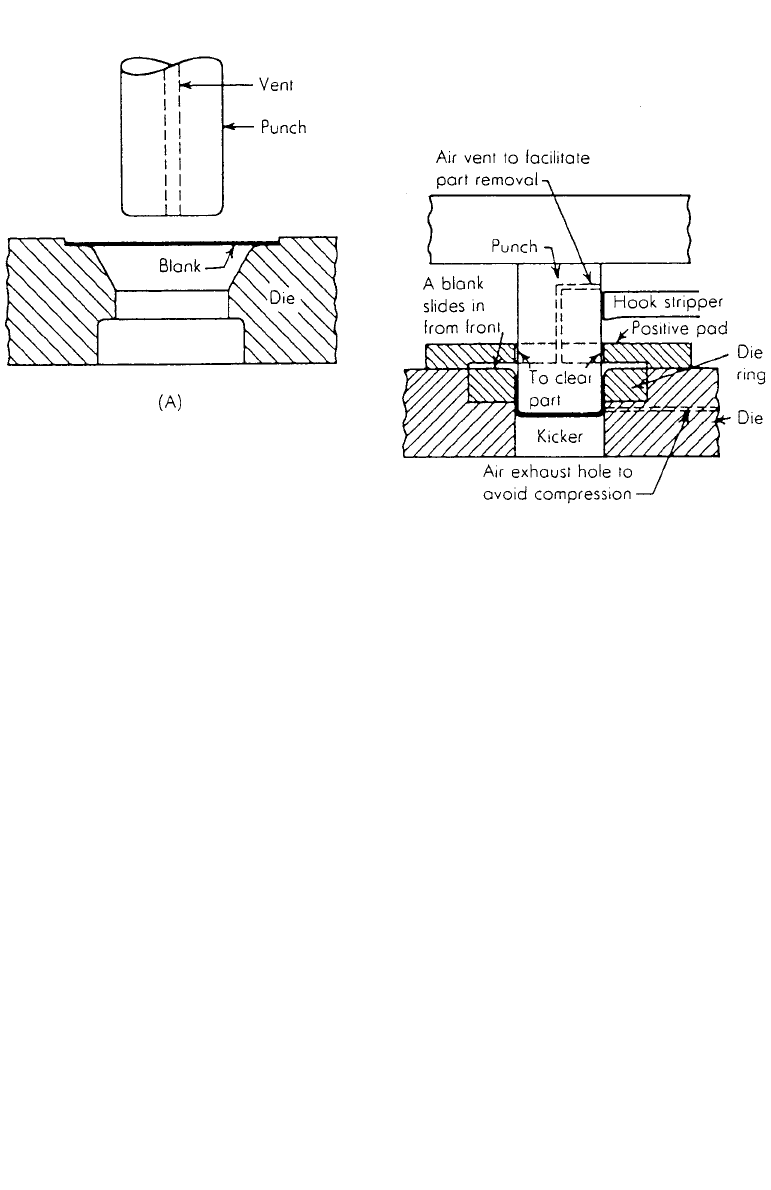
934 METAL FORMING, SHAPING, AND CASTING
Fig. 8 Drawing process.
where L ⫽ press load, lb
d
⫽ cup diameter, in.
D
⫽ blank diameter, in.
t
⫽ work-metal thickness, in.
S
⫽ tensile strength, lb/in.
2
k ⫽ constant that takes into account frictional and bending forces, usually
0.6–0.7
The force (load) required for drawing a rectangular cup can be calculated
from the following equation:
L
⫽ tS(2
Rk ⫹ lk ) (8)
AB
where L ⫽ press load, lb
t
⫽ work-metal thickness, in.
S
⫽ tensile strength, lb/in.
2
R ⫽ corner radius of the cup, in.
l
⫽ the sum of the lengths of straight sections of the sides, in.
k
A
and k
B
⫽ constants
Values for k
A
range from 0.5 (for a shallow cup) to 2.0 (for a cup of depth five
to six times the corner radius). Values for k
B
range from 0.2 (for easy draw
radius, ample clearance, and no blank-holding force) and 0.3 (for similar free
flow and normal blank-holding force of about L/3) to a maximum of 1.0 (for
metal clamped too tightly to flow).

2 HOT-WORKING PROCESSES 935
Figure 9 can be used as a general guide for computing maximum drawing
load for a round shell. These relations are based on a free draw with sufficient
clearance so that there is no ironing, using a maximum reduction of 50%. The
nomograph gives the load required to fracture the cup (1 ton
⫽ 8.9 kN).
Blank Diameters
The following equations may be used to calculate the blank size for cylindrical
shells of relatively thin metal. The ratio of the shell diameter to the corner radius
(d/r ) can affect the blank diameter and should be taken into consideration. When
d/r is 20 or more,
2
D ⫽ 兹d ⫹ 4dh (9)
When d/r is between 15 and 20,
2
D ⫽ 兹d ⫹ 4dh ⫺ 0.5r (10)
When d/r is between 10 and 15,
2
D ⫽ 兹d ⫹ 4dh ⫺ r (11)
When d/r is below 10,
2
D ⫽ 兹(d ⫺ 2r) ⫹ 4d(h ⫺ r) ⫹ 2
r(d ⫺ 0.7r) (12)
where D
⫽ blank diameter
d
⫽ shell diameter
h
⫽ shell height
r
⫽ corner radius
The above equations are based on the assumption that the surface area of the
blank is equal to the surface area of the finished shell.
In cases where the shell wall is to be ironed thinner than the shell bottom,
the volume of metal in the blank must equal the volume of the metal in the
finished shell. Where the wall-thickness reduction is considerable, as in brass
shell cases, the final blank size is developed by trial. A tentative blank size for
an ironed shell can be obtained from the equation
t
2
D ⫽ d ⫹ 4dh (13)
冪
T
where t
⫽ wall thickness
T
⫽ bottom thickness
2.6 Spinning
Spinning is a method of forming sheet metal or tubing into seamless hollow
cylinders, cones, hemispheres, or other circular shapes by a combination of ro-
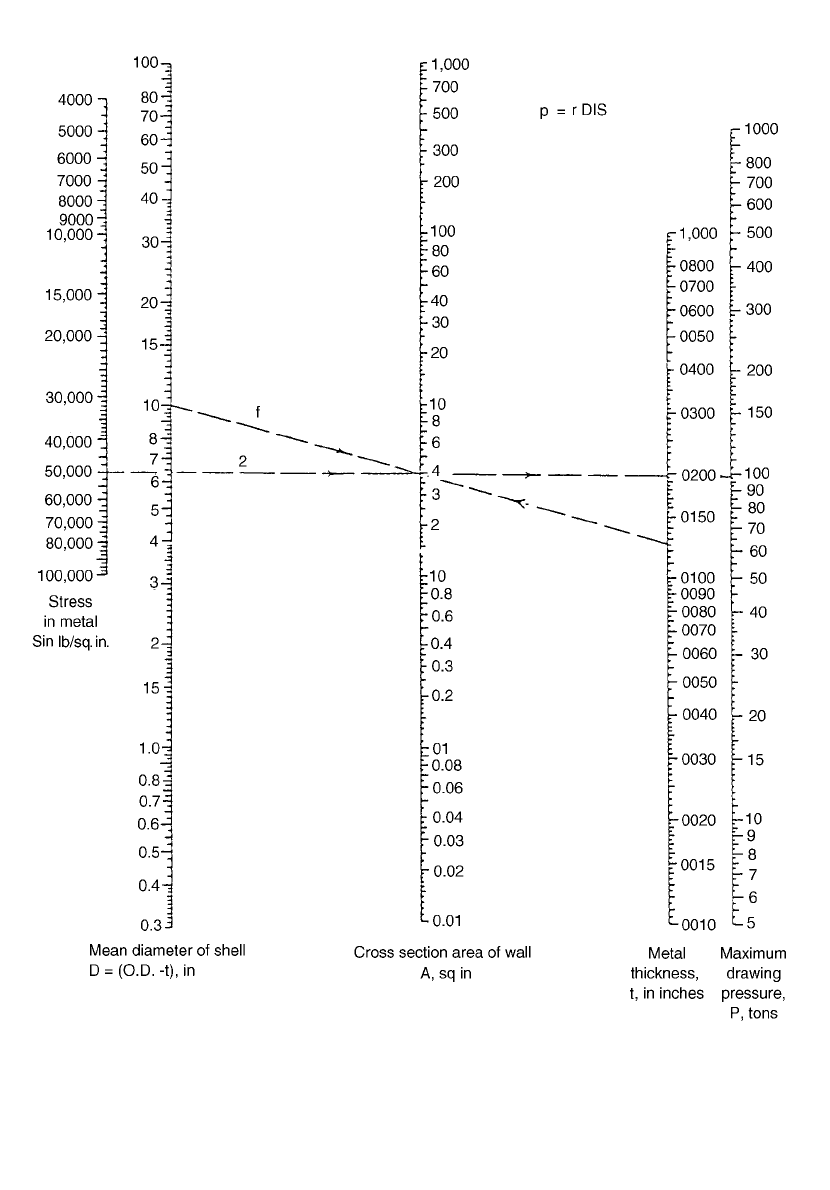
936 METAL FORMING, SHAPING, AND CASTING
Fig. 9 Nomograph for estimating drawing pressures.
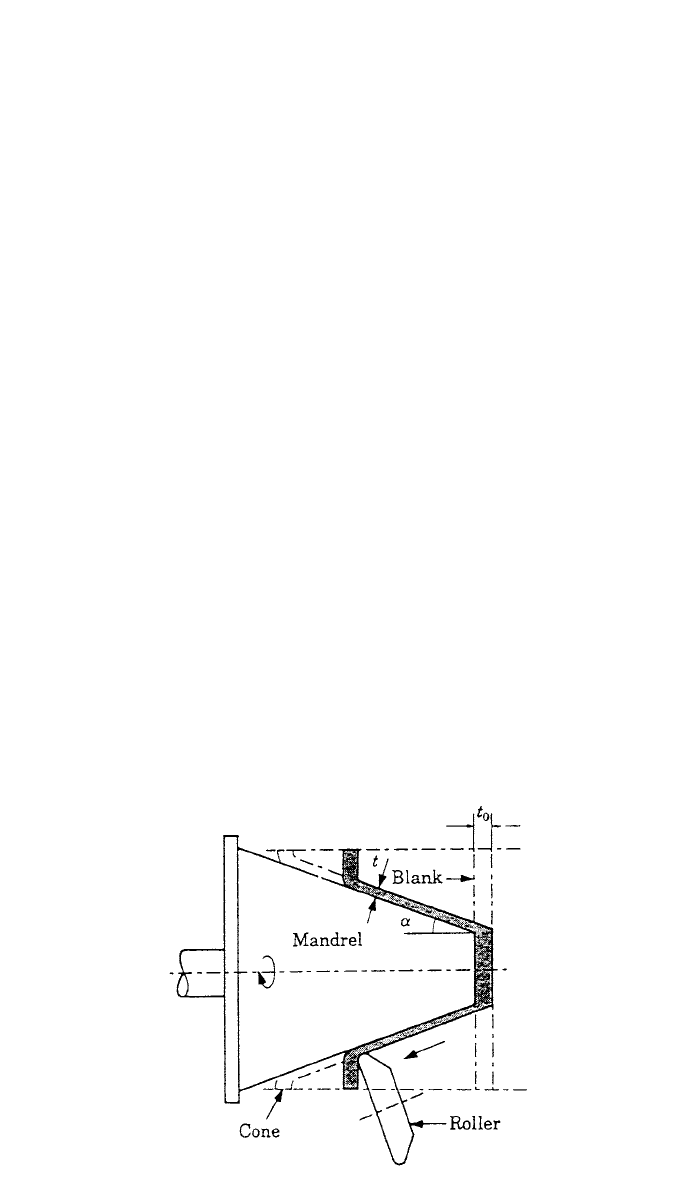
2 HOT-WORKING PROCESSES 937
Fig. 10 Setup and dimensional relations for one-operation power spinning of a cone.
tation and force. On the basis of techniques used, applications, and results ob-
tainable, the method may be divided into two categories: manual spinning (with
or without mechanical assistance to increase the force) and power spinning.
Manual spinning entails no appreciable thinning of metal. The operation or-
dinarily done in a lathe consists of pressing a tool against a circular metal blank
that is rotated by the headstock.
Power spinning is also known as shear spinning because in this method metal
is intentionally thinned, by shear forces. In power spinning, forces as great as
400 tons are used.
The application of shear spinning to conical shapes is shown schematically
in Fig. 10. The metal deformation is such that forming is in accordance with
the sine law, which states that the wall thickness of the starting blank and that
of the finished workpiece are related as
t
⫽ t (sin
␣
) (14)
21
where t
1
⫽ thickness of the starting blank
t
2
⫽ thickness of the spun workpiece
␣
⫽ one-half the apex angle of the cone
Tube Spinning
Tube spinning is a rotary-point method of extruding metal, much like cone spin-
ning, except that the sine law does not apply. Because the half-angle of a cylinder
is zero, tube spinning follows a purely volumetric rule, depending on the prac-
tical limits of deformation that the metal can stand without intermediate an-
nealing.
2.7 Pipe Welding
Large quantities of small-diameter steel pipe are produced by two processes that
involve hot forming of metal strip and welding of its edges through utilization
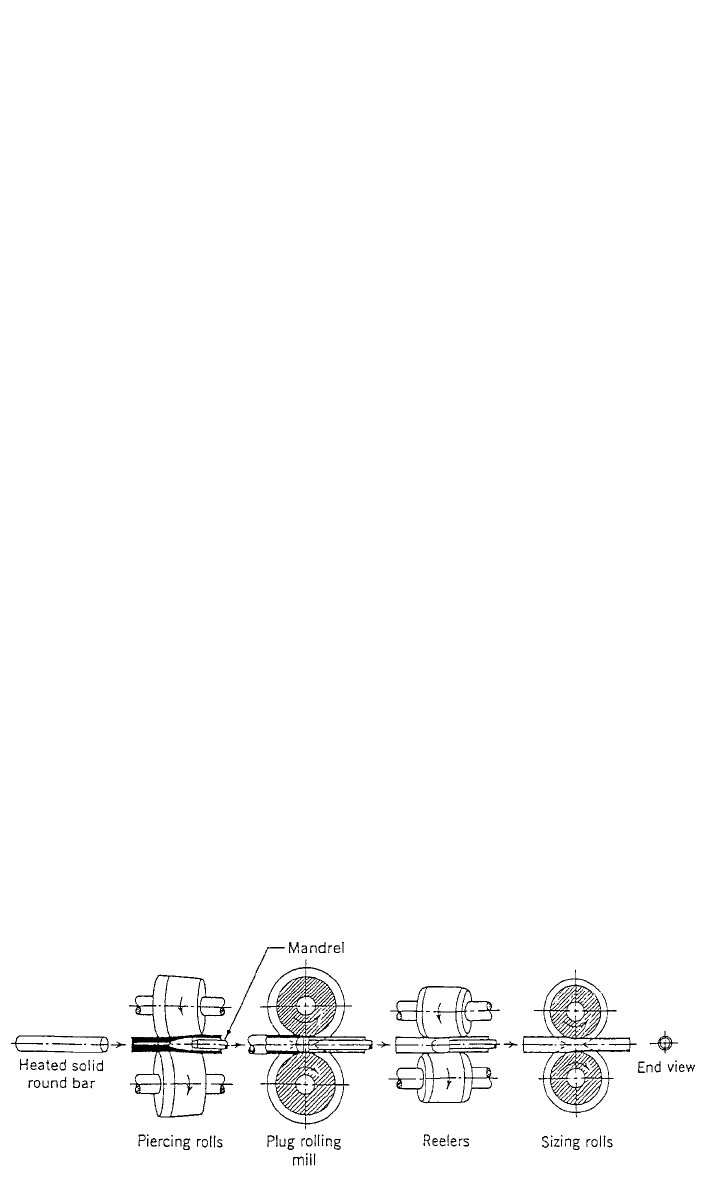
938 METAL FORMING, SHAPING, AND CASTING
Fig. 11 Principal steps in the manufacture of seamless tubing.
of the heat contained in the metal. Both of these processes, butt welding and lap
welding of pipe, utilize steel in the form of skelp—long and narrow strips of
the desired thickness. Because the skelp has been previously hot rolled and the
welding process produces further compressive working and recrystallization,
pipe welding by these processes is uniform in quality.
In the butt-welded pipe process, the skelp is unwound from a continuous coil
and is heated to forging temperatures as it passes through a furnace. Upon leav-
ing the furnace, it is pulled through forming rolls that shape it into a cylinder.
The pressure exerted between the edges of the skelp as it passes through the
rolls is sufficient to upset the metal and weld the edges together. Additional sets
of rollers size and shape the pipe. Normal pipe diameters range from –3 in.
1
–
8
(3–75 mm).
The lap-welding process for making pipe differs from butt welding in that
the skelp has beveled edges and a mandrel is used in conjunction with a set of
rollers to make the weld. The process is used primarily for larger sizes of pipe,
from about 2–14 in. (50–400 mm) in diameter.
2.8 Piercing
Thick-walled and seamless tubing is made by the piercing process. A heated,
round billet, with its leading end center-punched, is pushed longitudinally be-
tween two large, convex-tapered rolls that revolve in the same direction, their
axes being inclined at opposite angles of about 6
⬚ from the axis of the billet.
The clearance between the rolls is somewhat less than the diameter of the billet.
As the billet is caught by the rolls and rotated, their inclination causes the billet
to be drawn forward into them. The reduced clearance between the rolls forces
the rotating billet to deform into an elliptical shape. To rotate with an elliptical
cross section, the metal must undergo shear about the major axis, which causes
a crack to open. As the crack opens, the billet is forced over a pointed mandrel
that enlarges and shapes the opening, forming a seamless tube (Fig. 11).
This procedure applies to seamless tubes up to 6 in. (150 mm) in diameter.
Larger tubes up to 14 in. (355 mm) in diameter are given a second operation
on piercing rolls. To produce sizes up to 24 in. (610 mm) in diameter, reheated,
double-pierced tubes are processed on a rotary rolling mill, and are finally com-
pleted by reelers and sizing rolls, as described in the single-piercing process.

3 COLD-WORKING PROCESSES 939
3 COLD-WORKING PROCESSES
Cold working is the plastic deformation of metals below the recrystallization
temperature. In most cases of manufacturing, such cold forming is done at room
temperature. In some cases, however, the working may be done at elevated
temperatures that will provide increased ductility and reduced strength, but will
be below the recrystallization temperature.
When compared to hot working, cold-working processes have certain distinct
advantages:
1. No heating required
2. Better surface finish obtained
3. Superior dimension control
4. Better reproducibility and interchangeability of parts
5. Improved strength properties
6. Directional properties can be imparted
7. Contamination problems minimized
Some disadvantages associated with cold-working processes include:
1. Higher forces required for deformation
2. Heavier and more powerful equipment required
3. Less ductility available
4. Metal surfaces must be clean and scale-free
5. Strain hardening occurs (may require intermediate anneals)
6. Imparted directional properties may be detrimental
7. May produce undesirable residual stresses
3.1 Classification of Cold-Working Operations
The major cold-working operations can be classified basically under the headings
of squeezing, bending, shearing, and drawing, as follows:
Squeezing Bending Shearing Drawing
Rolling
Swaging
Cold forging
Sizing
Extrusion
Riveting
Staking
Coining
Peening
Burnishing
Die hobbing
Thread rolling
Angle
Roll
Roll forming
Drawing
Seaming
Flanging
Straightening
Shearing
Slitting
Blanking
Piercing
Lancing
Perforating
Notching
Nibbling
Shaving
Trimming
Cutoff
Dinking
Bar and tube drawing
Wire drawing
Spinning
Embossing
Stretch forming
Shell drawing
Ironing
High-energy rate forming

940 METAL FORMING, SHAPING, AND CASTING
Fig. 12 Cross sections of tubes produced by swaging on shaped mandrels. Rifling (spiral
grooves) in small gun barrels can be made by this process.
3.2 Squeezing Processes
Most of the cold-working squeezing processes have identical hot-working coun-
terparts or are extensions of them. The primary reasons for deforming cold rather
than hot are to obtain better dimensional accuracy and surface finish. In many
cases, the equipment is basically the same, except that it must be more powerful.
Cold Rolling
Cold rolling accounts for by far the greatest tonnage of cold-worked products.
Sheets, strip, bars, and rods are cold rolled to obtain products that have smooth
surfaces and accurate dimensions.
Swaging
Swaging basically is a process for reducing the diameter, tapering, or pointing
round bars or tubes by external hammering. A useful extension of the process
involves the formation of internal cavities. A shaped mandrel is inserted inside
a tube and the tube is then collapsed around it by swaging (Fig. 12).
Cold Forging
Extremely large quantities of products are made by cold forging, in which the
metal is squeezed into a die cavity that imparts the desired shape. Cold heading
is used for making enlarged sections on the ends of rod or wire, such as the
heads on bolts, nails, rivets, and other fasteners.
Sizing
Sizing involves squeezing areas of forgings or ductile castings to a desired thick-
ness. It is used principally on basses and flats, with only enough deformation to
bring the region to a desired dimension.
Extrusion
This process is often called impact extrusion and was first used only with the
low-strength ductile metals, such as lead, tin, and aluminum, for producing such
items as collapsible tubes for toothpaste, medications, and so forth; small ‘‘cans’’
such as are used for shielding in electronics and electrical apparatus; and larger
cans for food and beverages. In recent years, cold extrusion has been used for
forming mild steel parts, often being combined with cold heading.
Another type of cold extrusion, known as hydrostatic extrusion, used high
fluid pressure to extrude a billet through a die, either into atmospheric pressure

3 COLD-WORKING PROCESSES 941
or into a lower-pressure chamber. The pressure-to-pressure process makes pos-
sible the extrusion of relatively brittle materials, such as molybdenum, beryllium,
and tungsten. Billet-chamber friction is eliminated, billet-die lubrication is en-
hanced by the pressure, and the surrounding pressurized atmosphere suppresses
crack initiation and growth.
Riveting
In riveting, a head is formed on the shank end of a fastener to provide a per-
manent method of joining sheets or plates of metal together. Although riveting
usually is done hot in structural work, in manufacturing it almost always is done
cold.
Staking
Staking is a commonly used cold-working method for permanently fastening
two parts together where one protrudes through a hole in the other. A shaped
punch is driven into one of the pieces, deforming the metal sufficiently to
squeeze it outward.
Coining
Coining involves cold working by means of positive displacement punch while
the metal is completely confined within a set of dies.
Peening
Peening involves striking the surface repeated blows by impelled shot or a round-
nose tool. The highly localized blows deform and tend to stretch the metal
surface. Because the surface deformation is resisted by the metal underneath,
the result is a surface layer under residual compression. This condition is highly
favorable to resist cracking under fatigue conditions, such as repeated bending,
because the compressive stresses are subtractive from the applied tensile loads.
For this reason, shafting, crankshafts, gear teeth, and other cyclic-loaded com-
ponents are frequently peened.
Burnishing
Burnishing involves rubbing a smooth, hard object under considerable pressure
over the minute surface protrusions that are formed on a metal surface during
machining or shearing, thereby reducing their depth and sharpness through plas-
tic flow.
Hobbing
Hobbing is a cold-working process that is used to form cavities in various types
of dies, such as those used for molding plastics. A male hob is made with the
contour of the part that ultimately will be formed by the die. After the hob is
hardened, it is slowly pressed into an annealed die block by means of hydraulic
press until the desired impression is produced.
Thread Rolling
Threads can be rolled in any material sufficiently plastic to withstand the forces
of cold working without disintegration. Threads can be rolled by flat or roller
dies.
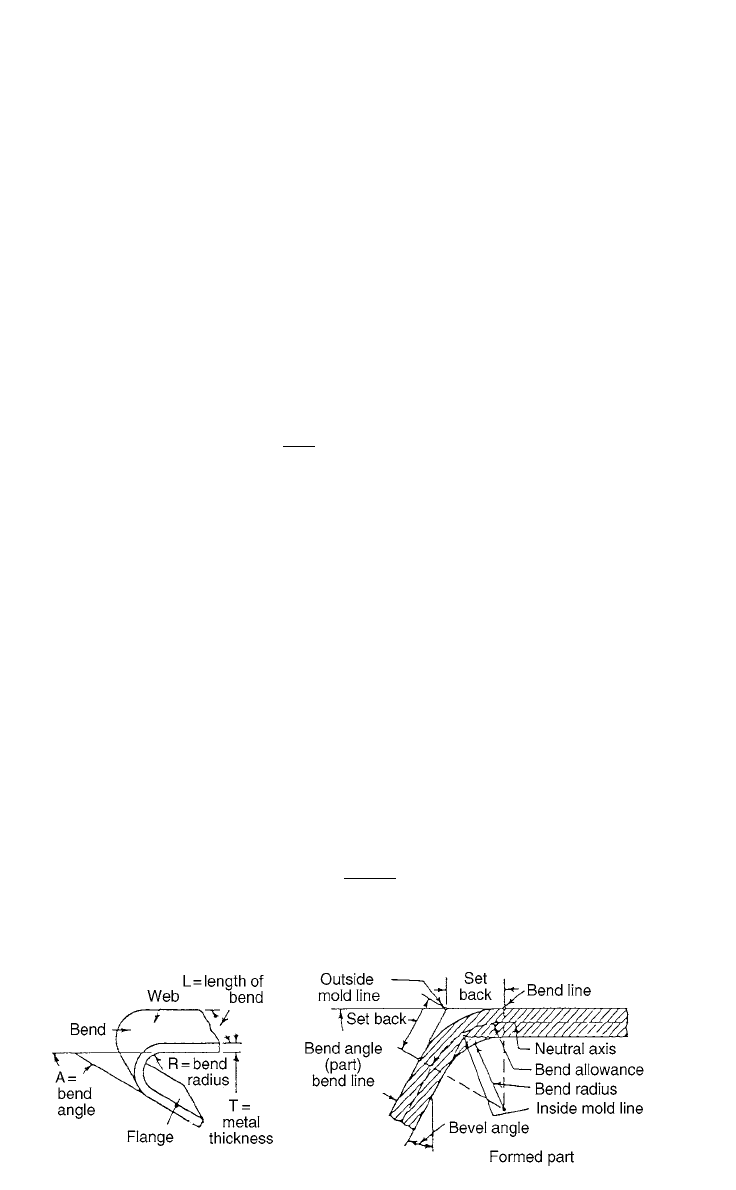
942 METAL FORMING, SHAPING, AND CASTING
Fig. 13 Bend terms.
3.3 Bending
Bending is the uniform straining of material, usually flat sheet or strip metal,
around a straight axis that lies in the neutral plane and normal to the lengthwise
direction of the sheet or strip. Metal flow takes place within the plastic range of
the metal, so that the bend retains a permanent set after removal of the applied
stress. The inner surface of the bend is in compression; the outer surface is in
tension.
Terms used in bending are defined and illustrated in Fig. 13. The neutral axis
is the plane area in bent metal where all strains are zero.
Bend Allowances
Since bent metal is longer after bending, its increased length, generally of con-
cern to the product designer, may also have to be considered by the die designer
if the length tolerance of the bent part is critical. The length of bent metal may
be calculated from the equation
A
B ⫽⫻2
(R ⫹ Kt ) (15)
i
360
where B
⫽ bend allowance, in. (mm) (along neutral axis)
A
⫽ bend angle, deg
R
i
⫽ inside radius of bend, in. (mm)
t
⫽ metal thickness, in. (mm)
K
⫽ 0.33 when R
i
is less than 2t and is 0.50 when R
i
is more than 2t
Bending Methods
Two bending methods are commonly made use of in press tools. Metal sheet or
strip, supported by a V block (Fig. 14), is forced by a wedge-shaped punch into
the block.
Edge bending (Fig. 14) is cantilever loading of a beam. The bending punch
(1) forces the metal against the supporting die (2).
Bending Force
The force required for V bending is as follows:
2
KLSt
P ⫽ (16)
W
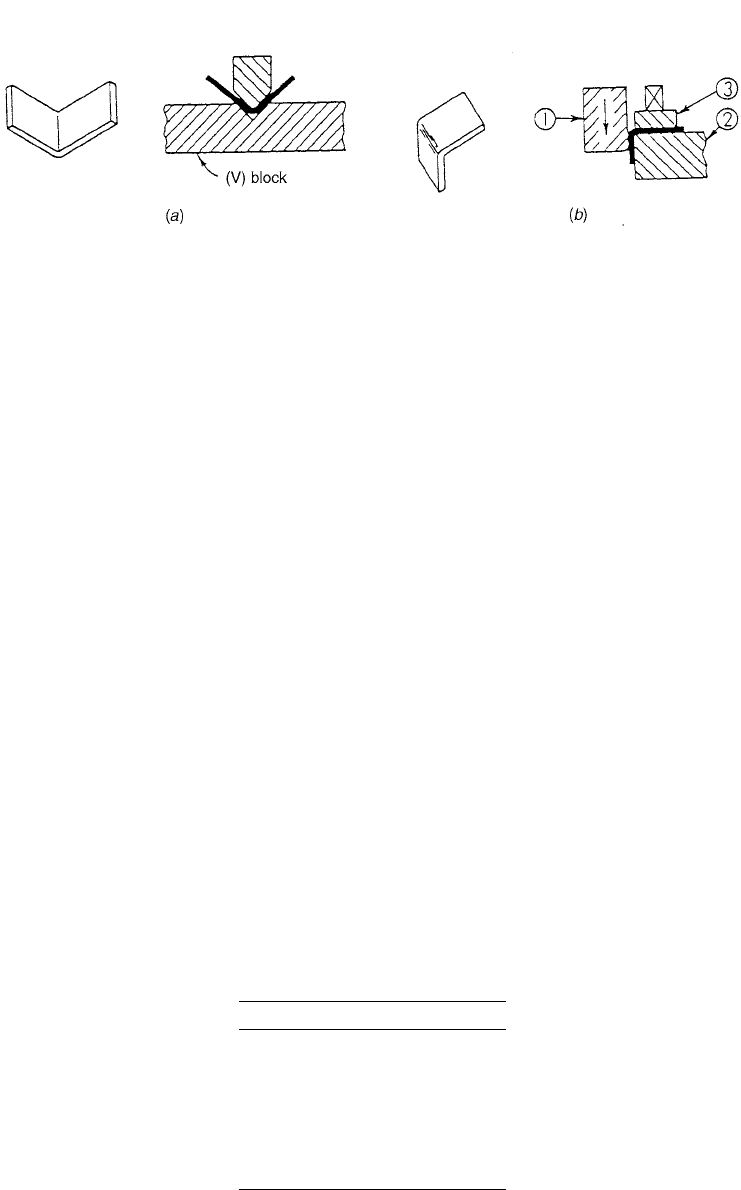
3 COLD-WORKING PROCESSES 943
Fig. 14 Bending methods: (a) V bending and (b) edge bending.
Table 1 Ultimate Strength
Metal (ton / in.
2
)
Aluminum and alloys 6.5–38.0
Brass 19.0–38.0
Bronze 31.5–47.0
Copper 16.0–25.0
Steel 22.0–40.0
Tin 1.1–1.4
Zinc 9.7–13.5
where P ⫽ bending force, tons (for metric usage, multiply number of tons by
8.896 to obtain kilonewtons)
K
⫽ die opening factor: 1.20 for a die opening of 16 times metal thick-
ness, 1.33 for an opening of eight times metal thickness
L
⫽ length of part, in.
S
⫽ ultimate tensile strength, tons/in.
2
W ⫽ width of V or U die, in.
t
⫽ metal thickness, in.
For U bending (channel bending), pressures will be approximately twice those
required. For U bending, edge bending is required about one-half those needed
for V bending. Table 1 gives the ultimate strength
⫽ S for various materials.
Several factors must be considered when designing parts that are to be made
by bending. Of primary importance is the minimum radius that can be bent
successfully without metal cracking. This, of course, is related to the ductility
of the metal.
Angle Bending
Angle bends up to 150⬚ in the sheet metal under about in. (1.5 mm) in
1
––
16
thickness may be made in a bar folder. Heavier sheet metal and more complex
bends in thinner sheets are made on a press brake.
Roll Bending
Plates, heavy sheets, and rolled shapes can be bent to a desired curvature on
forming rolls. These usually have three rolls in the form of a pyramid, with the
two lower rolls being driven and the upper roll adjustable to control the degree
